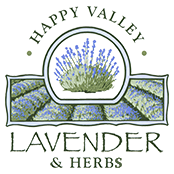|

September 2003
After the Harvest
Working with your dried Lavender Harvest
What do Lavender farmers do after the Harvest? They collapse on Sandpiper Beach on Hornby Island! So this month's edition doesn't come "on assignment" but from "on holidays"!
What do you do after your lavender harvest, big or small? First, take a break as the summer's heat does the job for all of us. It takes two to three weeks to dry. Sip Lavender Lemonade in the shade, nibble Lavender Shortbread or Biscotti - yes, you can drink coffee! (It is a herb after all!)
What next, you ask?
Well, this is where Lavender truly weaves a space into your heart and your home. Always a favourite in soaps & sachets in the infamous underwear drawer, I still remember my very first lavender article I wrote for "The Island Grower". It was actually a letter of complaint to the editors, Phyllis & Chuck, from Lady Lavender herself "submitted" by yours truly. It was to get "Lady Lavender" OUT of the underwear drawer!
By now, if you have visited my farm on our public days in July, you have been introduced to the idea of Lavender in food, maybe even tempted to sample the wares of my entrepreneur daughter & son at their stalls with Lavender treats. Then yearly I try to entice you further with a new Lavender recipe. Everything, yes, from Elizabethan Soap Balls to Lavender Lemon Curd to Lavender Brownies and back out of the kitchen to projects like Lavender Bath Bomz & Body Powder. This year was officially the "Easy Lavender Cheesecake of 2003"!
But I am jumping ahead of how you take your tidy stash of hanging bundles of Lavender into that lovely loose flow of flower buds to run your fingers through, breathing softly ...hmmm.
I feel like a lady of years gone by as every September around my Birthday, I have a Tea and Cake party: aka a "Rubbing Party" with treats. I invite friends to sit under the shade of my grandfather's venerable 93-year-old King apple tree, a cotton bed sheet spread over our knees with literally a heap of Lavender bundles in the middle! Methodically, we remove the simple "s" hanging hooks, leaving the elastic bands on, turning the bundle "flower heads down", and then rub the flower head end between our palms. The dry flower buds easily separate from the stems, falling onto the bed sheet. The bare stem bundles are set aside in a big cardboard box to use for scented fire starters for the winter hearth.
The next step is to remove any "litter" from twiggy broken stems to Bumblebee bums or the odd foreign blossom of dandelion or grass seed heads.
Using a simple circle screen from a Chinatown shop, about a foot in diameter, over a bowl; next the Lavender buds are lightly screened to remove any chaff, a couple of handfuls at a time.
The final Lavender colour will vary from grey-blue to blue-purple depending on the variety you have harvested. All colours fade slightly as they dry, with Lavandula angustifolia "Hidcote' keeping the deepest colour. Keep in mind this does not affect the taste; flavour depends on whether it is a Sweet Lavender (the angustifolias) or a Lavadin (L. x intermedia) or Spike (L. latifolia). All these three are edible, though personally I prefer the perfume quality of the angustifolias for cooking. (This choice also yields the finest perfume oil grade in Aromatherapy, the most expensive too.) I use the Lavadin & Spike for potpourris, dream pillow mixes and other crafts. (The "bunny eared" Spanish or L. stoechas is not recommended for food.)
Store your resulting dried Lavender buds in glass if at all possible or rigid plastic that will not easily absorb the precious essential oils. Keep any container away from light, heat and moisture for top condition. Stored correctly, it will keep its scent and taste for years
When using Lavender in a recipe that calls for fresh, the substitution ratio is one third of that amount dried. (Eg.3TBSP fresh= 1 TBSP dried) One pound dried Lavender equals roughly 15 cups or 100 TBSP.
Use your best in the kitchen, before crafts. Recycle last years dried Lavender to toss at a wedding or make Potpourris and Bath Salts. My long-standing recipe for Bath Salts is 1 cup dried Lavender, to 3 cups each of Epsom salts and fine oatmeal. I put a generous handful in a clean washcloth, secured with an elastic - easy to clean up, gentle to massage with wet in the tub. (Use 2 handfuls of the mix on stressful days!)
Save some of your dried Spike and Lavadin bundles to use in dried arrangements where their height is especially elegant. Their long heads tuck nicely into wreaths or dried posies. NOTE: The traditional Lavender wands are woven with thin ribbons only when fresh and flexible. See Frances, my daughter on our open house days. She has it down to a fine art now starting from when she was 5 years old.
I must warn you: if you realize how many ideas are tucked in this article you will be planting more Lavender come Spring!
"When I am old and wear purple" ...I will simply watch my Lavender bloom and let someone else harvest it. Or, watch them all go to seed - unpicked!
...Then turn the world purple and blue with all that promise of Lavender fields from the magic of seeds.
Originally published in the September 2003 edition of the Metchosin Muse
Printable Version 
|

